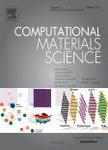版权所有:内蒙古大学图书馆 技术提供:维普资讯• 智图
内蒙古自治区呼和浩特市赛罕区大学西街235号 邮编: 010021

作者机构:Chinese Acad Sci Shenzhen Inst Adv Technol Shenzhen 518000 Guangdong Peoples R China Xiamen Univ Coll Mat Xiamen 361000 Fujian Peoples R China Xiamen Univ Fujian Prov Key Lab Mat Genome Xiamen 361000 Fujian Peoples R China Harbin Inst Technol State Key Lab Adv Welding & Joining Harbin 150001 Heilongjiang Peoples R China Harbin Inst Technol Shenzhen Inst Mat Genome & Big Data Shenzhen 518000 Guangdong Peoples R China
出 版 物:《COMPUTATIONAL MATERIALS SCIENCE》 (计算材料科学)
年 卷 期:2019年第160卷
页 面:95-104页
核心收录:
学科分类:08[工学] 0805[工学-材料科学与工程(可授工学、理学学位)]
基 金:National Key R&D Program of China [2017YFB0702901] Shenzhen Discipline Construction Project for Urban Computing and Data Intelligence, Joint Engineering Research Center for Health Big Data Intelligent Analysis Technology, China Postdoctoral Science Foundation [2018M633187]
主 题:Big data Machine learning Regression Steel properties Nonlinear programming
摘 要:Extracting the valuable information about the connections between the overall properties and the related factors from the industrial big data of materials is of significant interest to the materials engineering. At present, most data-driven approaches focus on building a relation model for a single property of the materials, where it may ignore the restrictive boundaries of other properties. In this paper, we propose a machine-learning-based method using nonlinear programming for multiple properties of the materials, and solve the problem by using the Interior Point Algorithm. The key idea is to take the mapping functions corresponding to the properties of the materials as the constraints of the nonlinear programming problem, thus it is capable of processing the restrictions of these properties. Moreover, with our method, the possible boundaries of these properties under certain conditions can be calculated. Experiments results on steel production data demonstrate the rationality and reliability of the proposed method.